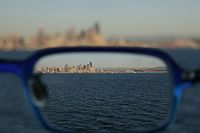A lens is a device that causes light to either converge and concentrate or to diverge. It is usually formed from a piece of shaped glass or plastic. Analogous devices used with other types of electromagnetic radiation are also called lenses: for instance, a microwave lens can be made from paraffin wax।
Lens construction

Most lenses are spherical lenses: lenses whose surfaces have spherical curvature, that is, the front and back surfaces of the lens can each be imagined to be part of the surface of a sphere. Each surface can be convex (bulging outwards from the lens), concave (depressed into the lens), or planar (flat). The line joining the centres of the spheres making up the lens surfaces is called the axis of the lens; in almost all cases the lens axis passes through the physical centre of the lens।
Uses of lenses
One important use of lenses is as a prosthetic for the correction of visual impairments such as myopia, hyperopia, presbyopia, and astigmatism. See corrective lens, contact lens, eyeglasses.
Another use is in imaging systems such as a monocular, binoculars, telescope, spotting scope, telescopic gun sight, theodolite, microscope, camera (photographic lens) and projector (projection lens). A single convex lens mounted in a frame with a handle or stand is a magnifying glass.
Large convex lenses have been used for hundreds of years to light fires by concentrating sunlight. In this use they are commonly called burning-glasses. Such a lens does not need to be optically accurate to work satisfactorily. A modern variation of this is the use of a lens in combination with a photovoltaic cell to concentrate sunlight and improve the efficiency of the device.
Radio astronomy and radar systems often use dielectric lenses, commonly called a lens antenna to refract electromagnetic radiation into a collector antenna. The Square Kilometre Array radio telescope will employ such lenses to get a collection area nearly 30 times greater than what is currently the largest antenna ever built.

No comments:
Post a Comment